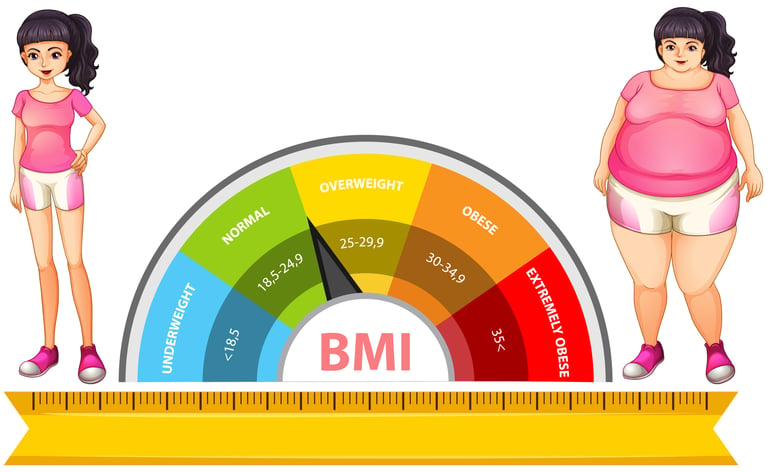Understanding BMI:
What It Is and Its Limitations


1. What is BMI?
Body Mass Index, or BMI, is a simple tool used to estimate whether your weight falls within a healthy range based on your height. While it doesn’t measure body fat directly, it offers a quick snapshot of your overall weight status and can help flag potential health risks. In this guide, we’ll break down what BMI is, how it’s calculated, what the numbers mean, and where it fits (and doesn’t fit) in understanding your true health
Body Mass Index (BMI) is a widely used tool for assessing body weight relative to height. It is calculated using the following formula:
BMI=Weight (kg)/(Height (m)
or, for those using pounds and inches:
BMI=Weight (lbs)x703/(Height (in)2
But to make live just a little bit easier, here's a BMI Calculator you can use:
The resulting number classifies individuals into different weight categories:
Underweight: BMI below 18.5
Normal weight: BMI 18.5 – 24.9
Overweight: BMI 25 – 29.9
Obese: BMI - 34.9
Extremely Obese: BMI 35 or more
BMI is commonly used by healthcare professionals as a quick screening tool to assess whether someone is at a healthy weight.
2. How BMI Works and Its Purpose
BMI is designed to provide a general estimate of body fat based on weight and height. It is useful in large-scale public health studies to identify trends in obesity, malnutrition, and disease risk.
Healthcare professionals use BMI to:
Identify individuals at risk for heart disease, diabetes, and hypertension.
Monitor population health trends over time.
Provide a starting point for further assessments related to body composition and overall health.
While BMI is useful for the general population, it has notable limitations, especially for specific groups like athletes and highly muscular individuals.
3. The Limitations and Disadvantages of BMI
1. BMI Does Not Distinguish Between Fat and Muscle
BMI simply considers total body weight, not body composition. This means:
Highly muscular individuals may be classified as overweight or obese despite having low body fat.
Someone with a low muscle mass but high body fat might fall within the "normal weight" range, despite having poor health markers.
For example, a well-trained bodybuilder with high muscle mass could have a BMI of 30+ (classified as obese) even though their body fat percentage is very low.
2. BMI Does Not Account for Fat Distribution
Where fat is stored on the body plays a crucial role in health. Visceral fat (fat around internal organs) is far more dangerous than subcutaneous fat (fat under the skin), yet BMI does not measure this.
Someone with a normal BMI but excessive visceral fat may still be at high risk for heart disease and metabolic disorders.
Conversely, someone with a high BMI but carrying weight in the form of lean muscle may be at a lower health risk.
3. Differences in Body Types and Ethnic Backgrounds
BMI does not account for variations in bone density, muscle composition, or genetic differences. Research has shown that:
Some ethnic groups (such as Asians) may have higher body fat percentages at lower BMIs, increasing disease risk.
People with naturally larger bone structures may be classified as overweight when they are actually in good health.
4. BMI Ignores Age and Gender Differences
Older adults naturally lose muscle mass, yet BMI may indicate they are at a healthy weight even if they have excessive body fat.
Women generally have a higher percentage of body fat than men, but BMI does not differentiate between the sexes when assessing health risks.
4. More Accurate Alternatives to BMI
While BMI is a convenient tool, it is best used alongside other health measurements for a complete picture of body composition:
1. Body Fat Percentage Measurements
Methods such as:
DEXA (Dual-Energy X-ray Absorptiometry) Scans
Skinfold Calipers
Bioelectrical Impedance Scales
These provide a clearer estimate of lean muscle mass vs. fat.
2. Waist-to-Hip Ratio (WHR) and Waist-to-Height Ratio
A high waist-to-hip ratio indicates abdominal fat, which is a stronger predictor of heart disease than BMI alone.
Waist-to-height ratio is gaining popularity as a better metric for health risks than BMI.
3. Visceral Fat and Metabolic Health Markers
Blood tests for cholesterol, blood sugar, and inflammation markers can help determine actual health risks.
Final Thoughts: Should You Rely on BMI?
BMI is a useful general guideline, but it should not be the only measure of health. If you are an athlete, have high muscle mass, or carry weight differently than the average person, BMI alone may not accurately reflect your health.
For a better assessment, combine BMI with body composition analysis, waist measurements, and metabolic health indicators to get a full picture of your well-being.
Would you like help finding the best method to track your health? Let me know!






